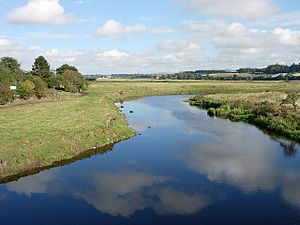Valley of Strathmore facts for kids

Strathmore (which means An Srath Mòr in Gaelic) is a long valley in east central Scotland. It stretches from the northeast to the southwest, nestled between two mountain ranges: the Grampian Mountains and the Sidlaws.
This valley is about 50 miles (80 km) long and 10 miles (16 km) wide. Most of Strathmore's ground is made of a type of rock called Old Red Sandstone. However, this rock is mostly covered by thick layers of clay, sand, and gravel. These layers were left behind by huge glaciers long ago. The valley's northeast to southwest direction is shaped by the ancient geological structure of the area. This structure reflects the main direction of the Caledonian mountain-building event that formed much of Scotland. The northern edge of Strathmore follows the line of the Highland Boundary Fault, a major crack in the Earth's crust. Strathmore is very fertile, meaning it has some of Scotland's best farmland. Farmers here grow soft fruits like berries and different types of cereals.
Exploring Strathmore's Past
The first records of this region come from Roman times. The Romans built a series of marching camps (temporary forts) that generally ran from south to north. These camps helped them explore and invade areas further north in Scotland. Other early signs of history in Strathmore include Pictish stones, which are ancient carved stones made by the Picts. A famous example is the Eassie Stone.
The title of Earl of Strathmore is named after this area. The main home of the Earl, Glamis Castle, is located right here in Strathmore.

